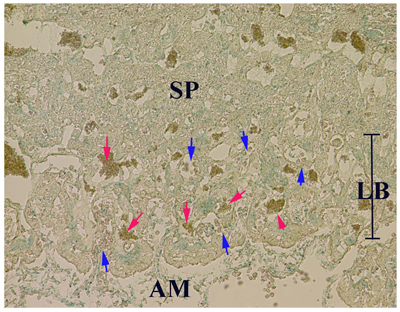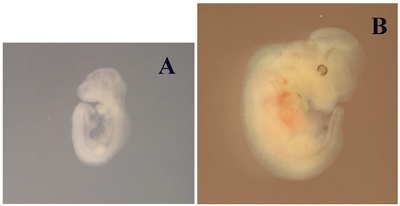|
Animal organs consist of several types of cells. They are organized in an ordered fashion wherein proportion of each cell type is maintained constant. The ordered cell arrangement and proportion are built up during organogenesis by cell-cell interactions. Since Notch has been postulated to play a role in cell fate decision by mediating cell-cell interactions, we are trying to find out cellular and molecular mechanisms working in organogenesis by studying function of Notch
Organogenesis of the mouse placenta occurs during early pregnancy, embryonic days 7-9, before the establishment of molecular transport mechanisms in the definitive placenta takes place. Trophoblasts not adjacent to the inner cell mass differentiate into trophoblast giant cells and lie at the outside, forming interface with maternal deciduas. The polar trophectoderm gives rise to cells of the chorion, and ectoplacental cone. They produce labyrinthine and spongiotrophoblast layer, respectively. While maternal red blood cells begin to perfuse into trophoblast cell layers and reach at labyrinthine layer by E9.5, invasion of embryonic allantoic mesenchyme into labyrinthine layer and differentiation of fetal red blood and endothelial cells which line fetal capillary takes place around E9.5.
The mutation in the ankyrin repeats of mouse Notch2 results in embryonic lethality by embryonic day 11.5 due to a poor maternal vascular beds formation. The mutant placenta showed an early invasion of angiogenic allantoic mesenchyme followed by premature formation of fetal blood vessels in the mutant placentas as early as E9.0. However, specification of trophoblast subtypes appeared not to be drastically disturbed. Thus, in the developing mouse placenta, Notch2 is unlikely involved in cell fate decision, but rather participates in a formation of circulatory systems in the labyrinth layer where the expression of Notch2 was detected (Fig 1). Although, inadequate formation of maternal vascular beds was partially restored by aggregating mutant diploid embryos with wild type teteraploid embryos (Fig.2), networks of the mutant fetal vasculatures and maternal blood spaces appeared still comprised in the 4N chimeric placenta. These results indicate that Notch2 works promotive in maternal vascular bed formation and prohibitive in fetal vasculogenesis. Thus, Notch2 is not cell autonomously required for the early cell fate determination of subtypes of trophoblast cells, but plays an indispensable role in coordinated maternal and fetal vasculogenesis in the developing mouse placenta.
|




